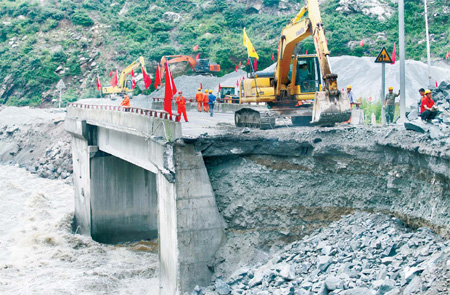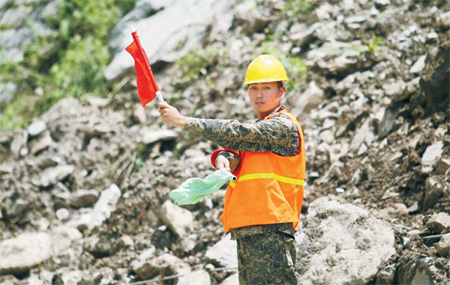Society
Battle to keep key route open
Updated: 2011-07-19 07:52
By Hu Yongqi (China Daily)
|
Workers are busy repairing the Luoquanwan Bridge in Shapingguan village in Wenchuan county, Sichuan province. The bridge was damaged by a mudslide early this month and is expected to reopen on Thursday. Photos by Feng Yongbin / China Daily |
|
It has taken more than 700 workers and 300 machines to reach this point in the repairs. |

Landslides play havoc with traffic on major national highway, Hu Yongqi reports from Wenchuan, Sichuan.
Luo Honglei can barely wait for Thursday. He will then be able to start his tractor-trailer, which has been parked in Wenchuan since July 3, and continue a delivery trip that usually takes just three days.
About 330 millimeters of rain fell on July 3, undermining sections of National Highway 213. During the night, 600 meters of road were either buried under rock and mud, or washed away.
It is the fifth time that landslides, triggered by heavy rain, have blocked the pivotal highway since May 12, 2008, when a devastating earthquake struck Wenchuan, in Sichuan province.
The integrity of the ground hasn't been the same since, experts say. Highway engineers struggle to restore the damaged highway after each landslide and try to prevent new ones. The work is expensive.
For road users, huge landslides are inconvenient, at the very least. They keep people like Luo from making deliveries on time.
National Highway 213 runs between Lanzhou, in Gansu province, and Mohan in Yunnan. Locally, it is the only major route between Wenchuan and Chengdu, Sichuan's capital. Rescue workers after the 2008 quake referred to a 59 km stretch of the road, from Wenchuan's Yingxiu township to its county seat, as a lifeline.
That's the route trucker Luo chose to deliver a 5-ton power transformer worth 1 million yuan ($153,900) from Chongqing to Lanzhou. He got no farther than Luoquanwan Bridge in Wenchuan's Shapingguan village.
"Because the process to reopen the highway was very difficult and slow, we wait for at least 18 days," Luo said. Detouring through neighboring Shaanxi province would have added 2,000 km to the trip, and the buyer refused to pay the additional cost.
So Luo and fellow driver Huang Ming have been sleeping in the cab of the truck, and a local family has provided them food for 20 yuan a day. But by the fifth day, both had already lost 4 kg.
A new phenomenon
Eleven townships in Wenchuan are affected by landslides that close Highway 213, said Zhu Rui, deputy county chief. Local people said they fear being swept away.
Four major slides occurred in July 2009 and in May, June and August 2010, and there were at least seven small slides in a 20-km stretch from Yingxiu township to Shapingguan village.
Ma Fuxiang, a highway maintenance worker in Yingxiu for more than 20 years, said there were "absolutely" no big landslides before 2008.
Hu Xiewen, a civil engineering professor at Southwest Jiaotong University in Chengdu, said there were only minor slides, and those are easy to clean up.
"When it rains heavily, we start to worry," Ma said as he cleared debris in the Mozigou section. "Sometimes, landslides suddenly fall from the mountainside and block the highway. My wife always asks me to be careful, but my job is to help the road management department keep the traffic uninterrupted."
On July 1, landslides blocked several sections of road, but emergency repairs by Sichuan Road & Bridge Co and county road workers had traffic flowing the next day.
On July 3, the Minjiang River changed course and cut through the highway, washing away 600 meters of road north of Luoquanwan Bridge.
If cars and trucks couldn't travel through the area, that left boats and feet.
Just in time
Wang Jiaming, 38, was in neighboring Dujiangyan on business July 6 when he got the message from his wife in Wenchuan: She had gone into labor. He knew that Highway 213 was the best route home, a two-hour drive. He didn't know the road was closed.
When he had to stop his truck, paramilitary forces told him he could take a boat across the new lake about 1 km away. Wang climbed over rocks and found his feet stuck in mud three times, but he kept going and reached the riverbank in 30 minutes. He found 20 villagers there, also waiting for a ride.
Wang said his mother had died in the earthquake never having seen a grandchild, and that nothing would keep him from seeing his child born. Then he could tell his mother about the new life that had come to the family.
About 30 minutes later, the boat arrived, and Wang broke into a smile. Once on the other side, he began walking with other Wenchuan natives. He covered the 30 km in time to witness the birth of his son.
High, steep, unstable
A makeshift road for passengers and cars opened on Friday, but trucker Luo's load is too heavy. Zhu, the county official, said Highway 213 is expected to be fully repaired and open on Thursday.
It has taken more than 700 workers and 300 machines to reach this point in the repairs.
The highway was severely damaged by the 2008 quake but was rebuilt. The route is still at the foot of Longmen Mountain, along the bank of the Minjiang, in the core of the earthquake zone.
The narrow watercourse is vulnerable to heavy rains that threaten the road base, said Feng Xuegang, general manager of Dujiangyan-Wenchuan Highway Co.
"The mountains along the highway are very high, mostly with a steep slope. This increases the possibility of landslides," said Huang Jinping, general manager of Sichuan Road & Bridge. He has been in charge of the operation in Wenchuan since July 3.
His company rebuilt the highway after the earthquake, and now it functions as the rapid reaction force to protect it. Huang said his employees have repaired about 100 sections of the highway since 2008.
When the rain continues after a slide, he said, it makes the repair work that much more difficult. "The rainy season usually begins in late July and lasts until September, but this year it is 15 days earlier and challenges us with more tasks to repair the highway."
Wang Xiang, an engineer with Sichuan Road, was instructing 20 workers on reinforcing the road base. They used a steel net and seven concrete piers, but still the floodwaters, running at 1,200 cubic centimeters a second, washed them away.
The mud and rocks provide unstable foundations for the heavy equipment, Huang said. A digging machine was trapped as it worked in the middle of the river, but the operator managed to escape. Four days later, it was pulled out the mud by another, larger digger.
Prevention methods
"As the geographical environment deteriorated after the earthquake, secondary land disasters kept happening. Maintaining sections of National Highway 213 is not only about traffic and transport, but also concerns with repeated landslides," said Gao Feng, director of Sichuan's transportation department. "Therefore, the maintenance of the highway also includes flood control and soil conservation."
After the earthquake, Sichuan's land and resources department examined 28,395 sites across the province for potential geographic disasters. More than 11,300 sites were in the quake-hit areas. Last year, work was completed to avert 181 potential disasters that might have affected 39,000 people, the department said.
A simple process is used on some hillsides: Foliage has been planted to hold the soil in place, and steel netting holds the plants to the slopes, at least until they are well established.
Xu Zhiwen, the department's deputy director, described a more elaborate approach - using heavier steel nets to contain debris that already has fallen so it doesn't travel farther or block a river. Rainwater can flow around the boulders and other debris and proceed down its normal, if swollen, course.
Last August, a landslide sent 800,000 cubic meters of rocks and soil down Hongchun Ravine, about half of it into the Minjiang River, damming it. Highway 213 was closed for about a week.
The technique that Xu described was launched in December, and Chengdu-based Huadi Co built 19 debris-controlling dams over six months. On July 3, Hongchun Ravine was able to withstand the deluge.
Xu said it costs 100-200 million yuan to restore one damaged ravine by containing its debris. Local authorities said they are short of money for flood control and soil conservation, but they know that those are the fundamental ways to keep traffic moving on National Highway 213.
Huang Zhiling and Li Yu contributed to this report.

(China Daily 07/19/2011 page1)
E-paper

The perfect cut
Companies need to revamp, standardize to stave off quality challenges
Crowning achievement
Living happily ever after
Let there be smell
Specials

My China story
Foreign readers are invited to share your China stories.

90th anniversary of the CPC
The Party has been leading the country and people to prosperity.

Setting the pace in Turkey
China is building a 158-km high-speed railway in Turkey.


